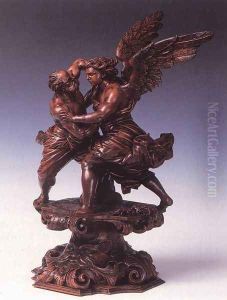Andrea Brustolon Paintings
Andrea Brustolon was an Italian sculptor who is often referred to as the 'Michelangelo of wood' due to his virtuosic carving skills and the dynamic, expressive nature of his work. He was born on July 20, 1662, in Belluno, a town in the Veneto region of Italy. The son of a woodcarver, Brustolon was immersed in the craft from an early age. He moved to Venice as a young man to study under the renowned sculptor and woodcarver Filippo Parodi, which greatly influenced his style and technique.
Brustolon's work is characterized by its baroque flamboyance, intricate details, and the dramatic movement of figures. His sculptures often depicted religious and mythological scenes, filled with life and energy that seemed to defy the limitations of the wooden medium. He was also known for his elaborate furniture pieces, which were highly sought after by the Venetian aristocracy and are still considered masterpieces of decorative art. These works often featured elaborate human figures, ornate foliage, and complex architectural elements.
During his lifetime, Brustolon created numerous altarpieces, statues, and other works for churches and public spaces in Venice and across the Veneto region. His most significant contribution was to the decorative arts, through his skillful integration of sculpture with furniture design, creating pieces that were both functional and highly artistic. His legacy includes a substantial influence on later generations of woodcarvers and sculptors in Italy and beyond.
Andrea Brustolon died on October 25, 1732, in his hometown of Belluno. Despite the regional focus of much of his work, his influence extended throughout Europe, contributing to the spread of the Baroque style. Today, his works can be found in museums, galleries, and private collections, where they continue to be celebrated for their technical mastery and emotive power.
